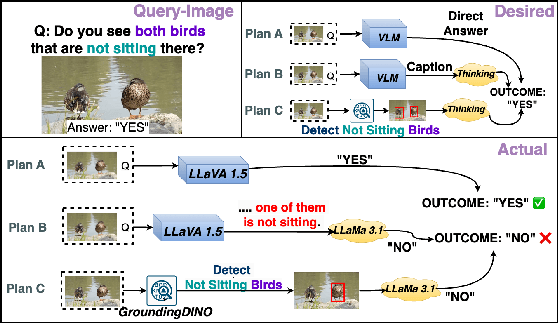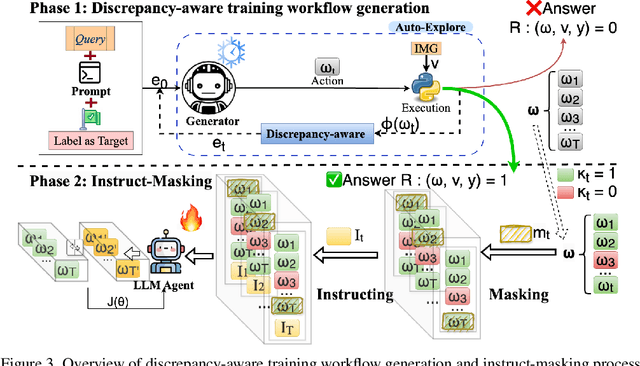Fucai Ke
Explain Before You Answer: A Survey on Compositional Visual Reasoning
Aug 24, 2025Abstract:Compositional visual reasoning has emerged as a key research frontier in multimodal AI, aiming to endow machines with the human-like ability to decompose visual scenes, ground intermediate concepts, and perform multi-step logical inference. While early surveys focus on monolithic vision-language models or general multimodal reasoning, a dedicated synthesis of the rapidly expanding compositional visual reasoning literature is still missing. We fill this gap with a comprehensive survey spanning 2023 to 2025 that systematically reviews 260+ papers from top venues (CVPR, ICCV, NeurIPS, ICML, ACL, etc.). We first formalize core definitions and describe why compositional approaches offer advantages in cognitive alignment, semantic fidelity, robustness, interpretability, and data efficiency. Next, we trace a five-stage paradigm shift: from prompt-enhanced language-centric pipelines, through tool-enhanced LLMs and tool-enhanced VLMs, to recently minted chain-of-thought reasoning and unified agentic VLMs, highlighting their architectural designs, strengths, and limitations. We then catalog 60+ benchmarks and corresponding metrics that probe compositional visual reasoning along dimensions such as grounding accuracy, chain-of-thought faithfulness, and high-resolution perception. Drawing on these analyses, we distill key insights, identify open challenges (e.g., limitations of LLM-based reasoning, hallucination, a bias toward deductive reasoning, scalable supervision, tool integration, and benchmark limitations), and outline future directions, including world-model integration, human-AI collaborative reasoning, and richer evaluation protocols. By offering a unified taxonomy, historical roadmap, and critical outlook, this survey aims to serve as a foundational reference and inspire the next generation of compositional visual reasoning research.
DWIM: Towards Tool-aware Visual Reasoning via Discrepancy-aware Workflow Generation & Instruct-Masking Tuning
Mar 25, 2025



Abstract:Visual reasoning (VR), which is crucial in many fields for enabling human-like visual understanding, remains highly challenging. Recently, compositional visual reasoning approaches, which leverage the reasoning abilities of large language models (LLMs) with integrated tools to solve problems, have shown promise as more effective strategies than end-to-end VR methods. However, these approaches face limitations, as frozen LLMs lack tool awareness in VR, leading to performance bottlenecks. While leveraging LLMs for reasoning is widely used in other domains, they are not directly applicable to VR due to limited training data, imperfect tools that introduce errors and reduce data collection efficiency in VR, and challenging in fine-tuning on noisy workflows. To address these challenges, we propose DWIM: i) Discrepancy-aware training Workflow generation, which assesses tool usage and extracts more viable workflows for training; and ii) Instruct-Masking fine-tuning, which guides the model to only clone effective actions, enabling the generation of more practical solutions. Our experiments demonstrate that DWIM achieves state-of-the-art performance across various VR tasks, exhibiting strong generalization on multiple widely-used datasets.
AR-Facilitated Safety Inspection and Fall Hazard Detection on Construction Sites
Dec 02, 2024Abstract:Together with industry experts, we are exploring the potential of head-mounted augmented reality to facilitate safety inspections on high-rise construction sites. A particular concern in the industry is inspecting perimeter safety screens on higher levels of construction sites, intended to prevent falls of people and objects. We aim to support workers performing this inspection task by tracking which parts of the safety screens have been inspected. We use machine learning to automatically detect gaps in the perimeter screens that require closer inspection and remediation and to automate reporting. This work-in-progress paper describes the problem, our early progress, concerns around worker privacy, and the possibilities to mitigate these.
Divide-Conquer Transformer Learning for Predicting Electric Vehicle Charging Events Using Smart Meter Data
Mar 20, 2024Abstract:Predicting electric vehicle (EV) charging events is crucial for load scheduling and energy management, promoting seamless transportation electrification and decarbonization. While prior studies have focused on EV charging demand prediction, primarily for public charging stations using historical charging data, home charging prediction is equally essential. However, existing prediction methods may not be suitable due to the unavailability of or limited access to home charging data. To address this research gap, inspired by the concept of non-intrusive load monitoring (NILM), we develop a home charging prediction method using historical smart meter data. Different from NILM detecting EV charging that has already occurred, our method provides predictive information of future EV charging occurrences, thus enhancing its utility for charging management. Specifically, our method, leverages a self-attention mechanism-based transformer model, employing a ``divide-conquer'' strategy, to process historical meter data to effectively and learn EV charging representation for charging occurrence prediction. Our method enables prediction at one-minute interval hour-ahead. Experimental results demonstrate the effectiveness of our method, achieving consistently high accuracy of over 96.81\% across different prediction time spans. Notably, our method achieves high prediction performance solely using smart meter data, making it a practical and suitable solution for grid operators.
HYDRA: A Hyper Agent for Dynamic Compositional Visual Reasoning
Mar 19, 2024



Abstract:Recent advances in visual reasoning (VR), particularly with the aid of Large Vision-Language Models (VLMs), show promise but require access to large-scale datasets and face challenges such as high computational costs and limited generalization capabilities. Compositional visual reasoning approaches have emerged as effective strategies; however, they heavily rely on the commonsense knowledge encoded in Large Language Models (LLMs) to perform planning, reasoning, or both, without considering the effect of their decisions on the visual reasoning process, which can lead to errors or failed procedures. To address these challenges, we introduce HYDRA, a multi-stage dynamic compositional visual reasoning framework designed for reliable and incrementally progressive general reasoning. HYDRA integrates three essential modules: a planner, a Reinforcement Learning (RL) agent serving as a cognitive controller, and a reasoner. The planner and reasoner modules utilize an LLM to generate instruction samples and executable code from the selected instruction, respectively, while the RL agent dynamically interacts with these modules, making high-level decisions on selection of the best instruction sample given information from the historical state stored through a feedback loop. This adaptable design enables HYDRA to adjust its actions based on previous feedback received during the reasoning process, leading to more reliable reasoning outputs and ultimately enhancing its overall effectiveness. Our framework demonstrates state-of-the-art performance in various VR tasks on four different widely-used datasets.
Graph Enhanced Reinforcement Learning for Effective Group Formation in Collaborative Problem Solving
Mar 15, 2024



Abstract:This study addresses the challenge of forming effective groups in collaborative problem-solving environments. Recognizing the complexity of human interactions and the necessity for efficient collaboration, we propose a novel approach leveraging graph theory and reinforcement learning. Our methodology involves constructing a graph from a dataset where nodes represent participants, and edges signify the interactions between them. We conceptualize each participant as an agent within a reinforcement learning framework, aiming to learn an optimal graph structure that reflects effective group dynamics. Clustering techniques are employed to delineate clear group structures based on the learned graph. Our approach provides theoretical solutions based on evaluation metrics and graph measurements, offering insights into potential improvements in group effectiveness and reductions in conflict incidences. This research contributes to the fields of collaborative work and educational psychology by presenting a data-driven, analytical approach to group formation. It has practical implications for organizational team building, classroom settings, and any collaborative scenario where group dynamics are crucial. The study opens new avenues for exploring the application of graph theory and reinforcement learning in social and behavioral sciences, highlighting the potential for empirical validation in future work.
Non-Intrusive Load Monitoring for Feeder-Level EV Charging Detection: Sliding Window-based Approaches to Offline and Online Detection
Dec 04, 2023Abstract:Understanding electric vehicle (EV) charging on the distribution network is key to effective EV charging management and aiding decarbonization across the energy and transport sectors. Advanced metering infrastructure has allowed distribution system operators and utility companies to collect high-resolution load data from their networks. These advancements enable the non-intrusive load monitoring (NILM) technique to detect EV charging using load measurement data. While existing studies primarily focused on NILM for EV charging detection in individual households, there is a research gap on EV charging detection at the feeder level, presenting unique challenges due to the combined load measurement from multiple households. In this paper, we develop a novel and effective approach for EV detection at the feeder level, involving sliding-window feature extraction and classical machine learning techniques, specifically models like XGBoost and Random Forest. Our developed method offers a lightweight and efficient solution, capable of quick training. Moreover, our developed method is versatile, supporting both offline and online EV charging detection. Our experimental results demonstrate high-accuracy EV charging detection at the feeder level, achieving an F-Score of 98.88% in offline detection and 93.01% in online detection.
HiTSKT: A Hierarchical Transformer Model for Session-Aware Knowledge Tracing
Dec 23, 2022Abstract:Knowledge tracing (KT) aims to leverage students' learning histories to estimate their mastery levels on a set of pre-defined skills, based on which the corresponding future performance can be accurately predicted. In practice, a student's learning history comprises answers to sets of massed questions, each known as a session, rather than merely being a sequence of independent answers. Theoretically, within and across these sessions, students' learning dynamics can be very different. Therefore, how to effectively model the dynamics of students' knowledge states within and across the sessions is crucial for handling the KT problem. Most existing KT models treat student's learning records as a single continuing sequence, without capturing the sessional shift of students' knowledge state. To address the above issue, we propose a novel hierarchical transformer model, named HiTSKT, comprises an interaction(-level) encoder to capture the knowledge a student acquires within a session, and a session(-level) encoder to summarise acquired knowledge across the past sessions. To predict an interaction in the current session, a knowledge retriever integrates the summarised past-session knowledge with the previous interactions' information into proper knowledge representations. These representations are then used to compute the student's current knowledge state. Additionally, to model the student's long-term forgetting behaviour across the sessions, a power-law-decay attention mechanism is designed and deployed in the session encoder, allowing it to emphasize more on the recent sessions. Extensive experiments on three public datasets demonstrate that HiTSKT achieves new state-of-the-art performance on all the datasets compared with six state-of-the-art KT models.
 Add to Chrome
Add to Chrome Add to Firefox
Add to Firefox Add to Edge
Add to Edge